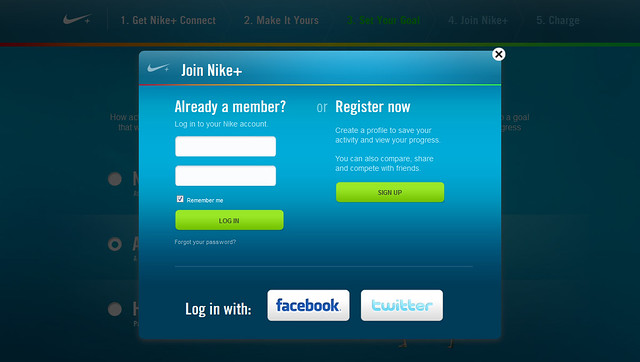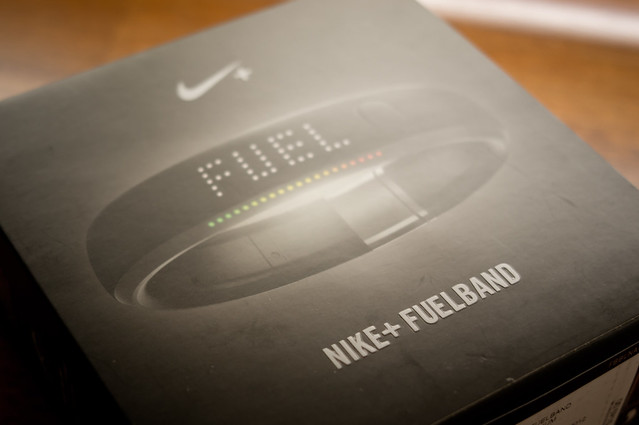Connect software. Using the Nike+ Connect Software First, plug your watch into a USB port on your computer. You can also use the USB cable that came with your watch. If you’re using a Mac, click the SportWatch icon on your desktop. If you’re using a PC, click the SportWatch icon located in My Computer. Or, it might launch automatically. Download Nike+ Connect - This is a versatile, practical and reliable software solution that helps you to quickly connect and configure your Nike+ watch or band.
We grumble. We procrastinate. We try fad diets. Of course, ultimately, weight loss comes down to burning more calories than you consume. But working out can be tough! Building up the motivation to exercise is the first great hurdle. Since the 2000s, technology has started to do its part in getting us up off the couch, out of the office and into the park for some bodily movement. Nike was one of the first companies to offer exercise tracking technology with Nike+, which uses a motion sensor to track the wearer's workout sessions and automatically catalog important information like calories burned, distance traveled and time spent working up a sweat.
From the latest products to the most exciting stories, the Nike App is your daily destination for the world of sport. Plus fast and secure checkout, free shipping and 30-day returns. The Latest Content Delivered Daily. From in-depth stories to training tips and style advice. View and Download Nike+ SportWatch GPS quick start manual online. Nike+SportWatch GPS Tom Tom. SportWatch GPS watch pdf manual download.
Nike+ and other exercise tracking systems are designed to motivate you. Nike+ lets you set goals for your workouts, helps you promote your successes to social networks and features friends lists so you can challenge your pals. When you can't have a workout buddy, being able to post scores and compete with your friends is the next best thing. Beyond motivation, these devices make exercising simpler. You're still going to have to put in the physical labor, but they'll take care of the number crunching by timing your workouts and figuring out how much exercise you're actually getting.
Nike Plus Setup Download
Advertisement

Advertisement
Nike+ began as a collaboration between Nike and Apple that worked with iPods, but it's since grown to include a number of devices like the Nike+ SportWatch GPS, FuelBand and SportBand. The SportBand was Nike's first addition to the Nike+iPod product line. What does that mean? Well, it's cheaper -- and a bit more limited -- than some later Nike+ accessories like the SportWatch. The SportBand is essentially a convenient display for exercise tracking data. Without a separate Nike+ sensor, it can't track your steps or burned calories -- it's just a digital watch.
At only $59 as of mid-2012, the SportBand is appropriately cheaper than the rest of the Nike+ line. We'll get into the why on the next page with the SportBand's hardware, then move onto the calorie-counting software and comparisons between the SportBand and Nike's newer FuelBand.
Advertisement
The Nike+ SportBand consists of two separate components. One of them is very, very simple. It's a rubber watch band. Just like any other watch band, pretty much, but with one exception: opposite the watch band holes is a small rectangular socket in the rubber. This slot is what secures the second component of the SportBand, which is actually a USB thumb drive. While the SportBand is water resistant, using the buttons underwater or exposing the SportBand to hot steam can be damaging. The thumb drive is made from curved plastic so it neatly rests atop the watch band, and it houses the SportBand's LCD display and a pair of control buttons on its surface.
The LCD can function as a plain digital watch, but its primary goal is to convey exercise information via a calorie counter, timer, distance gauge and pace meter. The button beside the display will start up exercise tracking, while a toggle button on the side of the device switches between functions. The SportBand's rechargeable battery lasts an estimated three weeks of daily one-hour workouts, while the memory is able to hold 30 hours of running data. The display is backlit, and the SportBand includes a 2.4GHz wireless receiver, but no transmitter.
Advertisement
Advertisement
That sums up the SportBand hardware: Unlike other exercise trackers, it doesn't contain a pedometer to track steps or an accelerometer to more accurately gauge movement. It also doesn't wirelessly upload information to the Nike+ Web site to allow you to see your exercise information -- you have to connect the detachable USB thumb drive to a computer to sync the data it collects.
By itself, the SportBand can't track your workout sessions. But the $59 band comes with a Nike+ sensor, which fits into any Nike+-ready shoe. This is where the wireless receiver comes in: The Nike+ sensor tracks your movement and transmits it to the SportBand. The sensor uses an accelerometer to track the motion of your foot and translate that into a step. Officially, the sensor fits into the insole of Nike+ shoes. Unofficially, you can use it with any running shoe by cutting a hole in the insole, stuffing it into the shoelaces or attaching it with tape.
The real draw of Nike+, of course, is what the software does with your exercise data.
Advertisement
We touched on the SportBand's simple LCD display on the hardware page, but it's obviously a key element of the software experience on the exercise tracker. There's not much to do on the SportBand itself, other than toggle between the display modes to see information about your current exercise session. The real Nike+ experience comes into play on a computer or mobile device. Nike offers a piece of software called Nike+ Connect for Mac and Windows. When the SportBand USB drive is plugged into a computer, it will dump its exercise data into that software, giving you access to charts, graphs, Nike+ friends and personal goals.
Nike+ information is available online, as well, making it accessible from any computer or mobile device with a Web connection. The software is free to download and use -- there's no membership fee for Nike+. The Web service allows you to set goals for exercise routines, like running faster or farther. It will help you keep track of calories burned and calorie goals. Nike+ also includes map data to plan runs and find easier or more challenging routes, depending on your preferences.
Advertisement

Advertisement
While you get immediate feedback from the Nike+ SportBand via the LCD as you run, you'll need to use the computer software or Web site to see data on previous workouts or interact with the Nike+ community. Some of Nike's other sports training devices, including the SportWatch GPS and the FuelBand, offer more functionality on their displays. We'll tackle those software differences on the next page.
In early 2012, Nike introduced the FuelBand, a new take on the Nike+ functionality. The $149 FuelBand costs nearly triple what the SportBand does, but offers a different experience in both hardware and software. Most obviously, it's thinner and more stylish. There's no removable USB component in the FuelBand -- it's a solid piece that connects to a computer via a built-in USB port. The FuelBand's display and color LEDs, which are used to show workout progress, are more subtly integrated into the wristband body. And here's the important addition: The FuelBand includes an accelerometer, meaning it can track your motion as you walk and run without communicating with an external Nike+ sensor.
When it comes to software, the FuelBand is completely different from the SportBand. Nike developed a new points system called 'Nike Fuel' which essentially abstracts the exercise you're getting into a generic number. You're not burning 300 calories -- you're earning 700 fuel points. You can still set goals with Nike Fuel and see charts and graphs depicting your workouts, but the focus of the FuelBand experience is on that custom number.
Advertisement
Advertisement
The FuelBand can sync with iOS devices via Bluetooth and give you instant access to your exercise data. It's obviously designed to be a more streamlined experience than the traditional Nike+ system, but some fitness nuts may prefer the straightforward, universally-recognized data Nike+ used prior to the switch to fuel points.
The older SportWatch GPS is even more expensive than the FuelBand at $199, but it's also more complex than either of the other Nike+ trackers. The SportWatch uses GPS and an accelerometer to track location and exercise and has a larger display than the SportBand. It's naturally the largest of the three Nike+ accessories. All of them connect to the same Nike+ computer software and have access to data via the Web, though as of April 2012, the Nike Fuel system is segmented off from regular Nike+ data and community features. Nike plans to overhaul the entire Nike+ platform, putting Fuel front and center, in summer 2012.

iPhone and iPod owners considering a SportBand can check out Nike+ without buying the dedicated wristband. The Nike+ iOS app performs GPS tracking just like the SportWatch, and the fifth and sixth generation iPod Nano includes a pedometer for tracking every beat-driven step.

Advertisement

It's an interesting time for sports gear, which made comparing the SportBand and newer Nike+ devices interesting. Everything's changing as accelerometers become commonplace in smartphones. There's a lot of competition in exercise tracking between the Jawbone Up, the Fitbit and Nike+. The SportBand has been around for years, and I think the new Nike+ FuelBand is more interesting -- it tries to abstract calorie counts and the stuff we get so hung up with and replace that with a more rewarding system. 'Gamification' is an interesting phenomenon, and competition and rewards can lead to great results. Still, we risk running into a problem: working for the arbitrary reward instead of the end goal itself.
Related Articles
Sources
- Bishop, Bryan. 'Nike+ FuelBand review.' March 8, 2012. (April 24, 2012) http://www.theverge.com/2012/3/8/2853088/nike-fuelband-review
- Bumgardner, Wendy. 'iPod nano Pedometer Review.' July 4, 2010. (April 23, 2012) http://walking.about.com/od/prpedometer/fr/ipodpedometer.htm
- MobiHealthNews. 'The World of Health and Medical Apps.'(May 7, 2012) http://mobihealthnews.com/research/the-world-of-health-and-medical-apps/
- Nike.com. 'Nike+ SportBand.' (April 22, 2012) http://nikeplus.nike.com/plus/products/sport_band/
- Nike.com. 'Nike+ SportWatch GPS.' (April 22, 2012) http://nikeplus.nike.com/plus/support/#answers/detail/a_id/20895/p/3169,3179
- Podophile.com. 'Inside the Nike+iPod Sport Kit.' Aug. 8, 2006. (April 23, 2012) http://podophile.com/2006/08/08/inside-the-nikeipod-sport-kit/
- Vogel, Sandra. 'FitTechnica: Nike+ GPS App for iPhone review.' Oct. 21, 2010. (April 24, 2012) http://www.fittechnica.com/2010/10/nike-gps-app-for-iphone-review.html
Advertisement
Nike Plus Download Software
Advertisement
